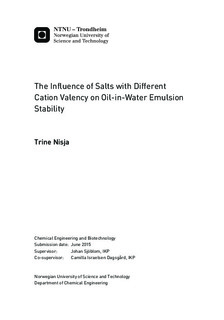The Influence of Salts with Different Cation Valency on Oil-in-Water Emulsion Stability
Master thesis
Permanent lenke
http://hdl.handle.net/11250/2351674Utgivelsesdato
2015Metadata
Vis full innførselSamlinger
Sammendrag
The effect of different emulsion preparation parameters on the stability of oil-in-water (o/w)emulsions has been studied by varying the preparation parameters and then observing the emulsionvisually. Change in the turbidity of an emulsion indicated instability, and the formation of adense layer on the top of the emulsion suggested that creaming had commenced. The creamingrate was diminishing with increasing mixing frequency, mixing time and oil phase density. Thestudy was limited by foam build-up, as the unwanted foam made it necessary to keep mixingfrequency and surfactant amount to a minimum.The influence of diluted salts of different valencies on the stability of o/w emulsions has beeninvestigated bymeasuring the zeta potential of emulsionswith varying electrolyte concentrationand electrolyte cation valency. The destabilising effect of adding divalent Ca2+ was stronger thanthat ofNa+, whichwas observed by the difference in electrolyte concentration required to reducethe absolute value of zeta potential. This strongly implies that the higher valency of Ca2+ morereadily contributes to a compression of the electrical double layer than does Na+. Contrary toexpectations, the addition of trivalent Al3+ and Fe3+ was not observed to affect the stability. Itwas concluded that this deviation from theory was due to experimental limitations.A new method for droplet size characterisation and oil profile for w/o emulsions with low-fieldnuclear magnetic resonance (NMR) has been developed and tested for o/w emulsions in collaborationwith the NMR supplier, Antek AS. Implementation of a convection compensatingsequence by Antek AS was successful. The new procedure makes it possible to retrieve quantitativedata on the droplet size and oil profile of an o/w emulsion over time, which can providegood insight into emulsion stability.
